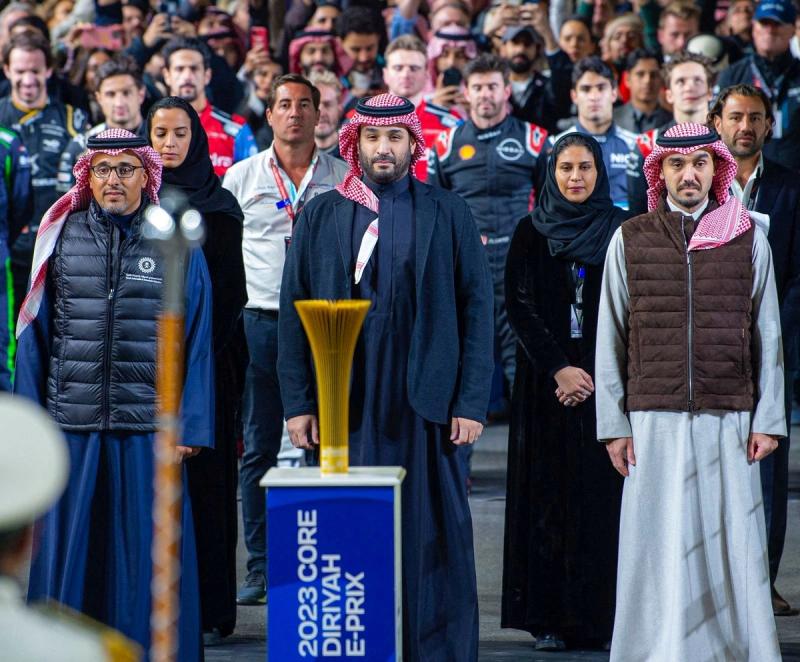
Camilla Wright is a media commentator and writer for global news and pop culture outlets, and publishes Britain’s biggest and best known newsletter.
Expensive skyscrapers, shopping malls, and freeways are being carved out of the red-gold sands of the desert, as Saudi Arabia’s Crown Prince Mohammed bin Salman seeks to turn Riyadh from a conservative backwater to a city at the forefront of tomorrow’s world.
To the Western eye, it might seem that MBS is showing the world that the new Saudi Arabia is a young and flashy amalgam of construction sites and sci-fi city planning, with a dash of esports and AI thrown in. But this is all merely window dressing. Scratch a little deeper and it’s not just a new city that is being built. Behind the scenes, something deeper and far more interesting is going on. The Kingdom is recasting its whole national identity.
Nation building isn’t just aster of glass, cement, and stone. National identity is constructed from a set of creation myths that give people a sense of shared history and values; fabricating something resonant from fragments of the past.
In Riyadh, along with these shimmering structures, a new national story is being created, and told. It is a story that links MBS and his shiny new capital city with everything that has gone before in Arabia. It’s a story that affirms national identity outside religion and beyond oil, and imbues the country with a history that glosses over the past few decades. This new Saudi brand sits in a parallel universe to the story that the West thinks it knows.
The profusion of cranes currently visible across the skyline of the west side of Riyadh is the beating heart of this creation myth. Diriyah — the ancestral base of the House of Saud, built from mud bricks along the banks of Wadi Hanifa — is being brought front and center as the living embodiment of a Saudi state dating back 600 years.
Ruins reshaped and reconstructed as the birthplace of the modern Saudi nation, Diriyah is home both to the historic mud palaces of the UNESCO world heritage site at-Turaif and Michelin-renowned restaurant brands and entertainment spaces of Bujairi Terrace.

At night, projected on the very walls of Al-Turaif palace to both Saudis and visitors, is a video which places the legitimacy of MBS’ kingdom back into the recesses of time, long before the modern Saudi state was formed in 1932, and even before the creation of its precursor, in the 18th century.
It sets out ideals and values: “The foundation of the Saudi state is Mohammad ibn Saud’s family legacy... it became a powerful state that promoted unity, stability, and prosperity.” It argues for a modern, strong Saudi Arabia with 600-year-old roots centered on Diriyah, with the Al Saud family legacy at its heart, “ruled by the principles of stable governance and unity.”
All nations have creation myths, some newer than others: Think of how the classic cowboy stories of vintage Hollywood romanticized the “how the west was won” tales that sit at the core of how the US sees itself. Or how a “Rule Britannia” island ethos mixes with Churchillian “never surrender” motifs, creating an enduring narrative which both fuels and holds back the United Kingdom.
Saudi Arabia’s creation myth seeks to legitimize the current rulers not as a lucky tribe who happened to be in place when oil was struck and cash started to pour in — the tale often dismissively told of the country’s founding. Instead it is creating a story that this Saudi Arabia has a long, stable and storied history as the powerful and prosperous centrepoint of the region. And in this history, Saudi Arabia’s importance is not just derived from its position as the custodian of the two holy mosques.
The only story that was previously told or understood by the rest of the world intertwined the Saudi narrative with its religious story. Now, a national identity is being constructed that is gently pulling this apart. The creation of secular public holidays — like the upcoming four-day National Day celebrations — has been a groundbreaking statement for a country which had until the last few years entirely defined itself through its commitment to its religion. The renaissance of Diriyah is also central to this secularization. Left to rot for decades due to its lack of religious significance, its rebirth is core to the nation’s new character.
The Starbucks and McDonald’s you see in almost every strip mall in Riyadh are not the only US ideas imported. For as movies created Americana in the 20th century, so the 21st century Saudi Arabia is looking to get buy-in from its population — as that clever animated movie at Diriyah showed.
The historian Robert Lacey described how the ancient forefathers of the Al Sauds somehow managed to create this ancient city from mud and sand right in the heart of the unforgiving Arabian desert as “an enduring reminder of the frontiers of the possible”. By constructing for itself a whole new story, Saudi Arabia is telling the world that it’s taken that reminder to heart.

